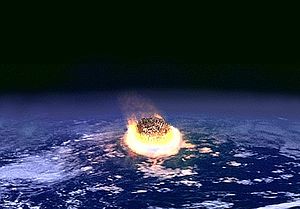A new study finds strong evidence that an asteroid or comet hit the earth about 13,000 years ago and may have played a role in a dramatic climate shift around that time. A 16 member team from UC Santa Barbara has found nanodiamonds and other artifacts of the theoritical impact which fits like a glove with a sudden cold snap at the end of the most recent ice-age called the Younga Dryas:
(Red Orbit) — The data suggest that a comet or asteroid –– likely a large, previously fragmented body, greater than several hundred meters in diameter –– entered the atmosphere at a relatively shallow angle. The heat at impact burned biomass, melted surface rocks, and caused major environmental disruption. .. The sediment layer identified by the researchers is of the same age as that previously reported at numerous locations throughout North America, Greenland, and Western Europe. The current discovery extends the known range of the nanodiamond-rich layer into Mexico and the tropics.
If you play around with impact simulators, and make some middle of the road assumptions, the consequences of of an object 400 meters in diameter are significant.
Via the Purdue University Earth Effects Program: assuming you are 100 km away, a rocky object 400 meters in diameter arriving at 20 km/s at a 30 degree angle striking sedimentary rock produces a crater almost five km across and 500 meters deep. It delivers 4.26 gigatons of TNT blast and is ten times brighter than the sun (Meaning if you saw it streak overhead or hit on the horizon it would blind you at least temporarily and probably do permanent damage to your retina as well as giving you first degrees burns over any exposed skin). Fragments over an inch in size would rain down for several minutes at least, setting everything on fire, and magnitude 7 quake would be felt for a hundred miles or more from the blast.


Very interesting.
I’ve been working on the future history of a science fiction novel, with an asteroid impact serving as the impetus for developing interstellar space travel (some notes, if anyone is interested.) I have the impact itself, but need information on what the aftermath would look like; this article will be useful.
Can I bask in reflected glory for a moment? I got my MS under Jim Kennett at the oceanography school at URI back in the 80s. A couple of years ago, I happened to be in Santa Barbara and dropped by to say hi. He wasn’t in, though. He was doing field work in Greenland (summertime, of course) looking for evidence of this impact. Don’t know if he found anything there, but I guess he did eventually find it!
Impacts really aren’t that uncommon. In North America alone, there was the K/T boundary impact in Yucutan that killed the dinosaurs (and many other animals and plants), and a sizable impact I think about 30 million years ago that left a huge crater under Chesapeake Bay. There’s an enormous impact basin under Sudbury, Ontario about 1.8 billion years old (that I’ve visited) that contains the world’s largest nickel mine, and of course Meteorite/Barringer Crater in Arizona (that I’ve also visited). There was even a large wave in 1992 that washed ashore in Daytona that may have been caused by a 1 meter meteorite. There was also a woman in the 1950s that I recall reading about that was hit by a meteorite that came through her roof. With so many people on this planet, sooner or later it’s going to happen again. Estimates are that we get hit by a big dino-killer type every 100 million years ago.
Damn. That should be “every 100 million years or so“
So is this the event that caused Rush Limbaugh’s brain to go extinct?
Very cool gvl!
Hmm. This appears to coincide with the disappearance of the Clovis culture: http://en.wikipedia.org/wiki/Clovis_people
Quick, somebody call Eric Hovind we have more evidence he needs to deny!
That is an interesting point John ..
So would this be the two comets that Ignatius Donelly writes about in The Destruction of Atlantis – Ragnorok, or the Age of Ice and Gravel back in 1883? He quotes numerous legends and myths to support his ideas.
Just noticed – it’s the “Younger Dryas”, not the “Younga Dryas”. The Younger Dryas wasn’t really a full-fledged ice age, it was a temporary ~1000 yr advance from 13,000-12,000 years ago, during the deglaciation that started at about 18,000 yrs ago. It was probably caused by meltwater reaching the North Atlantic. (I did a term paper during grad school on this event.)